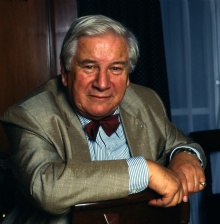"Laughter would be bereaved if snobbery died"
About this Quote
Peter Ustinov’s remark, “Laughter would be bereaved if snobbery died,” deftly links humor and social hierarchy. The statement suggests that snobbery, the belief in the superiority of certain classes, tastes, or individuals, acts as fertile ground for wit and comedic observation. Comedy, throughout history, has mined the foibles of the proud, the pretentious, and those obsessed with status. Laughter is often provoked by the exposure, exaggeration, or subversion of these societal affectations.
Snobbery creates the incongruity and absurdity upon which humor thrives. The self-important, pompous, or vain invite mockery; their insistence on distinction or refinement is easily punctured by irony, satire, and parody. From Shakespeare’s Malvolio to the social climbers and aristocrats of Oscar Wilde, snobby characters are reshaped into objects of ridicule. By drawing attention to the pettiness, insecurity, or hypocrisy inherent to snobbery, writers and comedians both chastise and humanize those consumed by status, enabling audiences to laugh at what might otherwise provoke envy or resentment.
Without snobbery, many familiar comedic scenarios crumble. The follies of social climbing, the awkward attempts to “fit in” with the upper crust, or the pomposity of the privileged lose their targets. Humor often relies on the vanities of those who deem themselves “better than,” making their inevitable comeuppance all the more satisfying. Laughter, in this sense, is both a coping mechanism and a gentle equalizer, masking criticism in amusement and thus making it more palatable.
Ustinov’s observation also hints at a bittersweet truth: while laughter can heal and unite, it sometimes arises from division and folly. If snobbery vanished, society’s propensity for self-importance might diminish, but so, too, would one of comedy’s richest subjects. Thus, for as long as humans arrange themselves into hierarchies, laughter will find sustenance in the earnest absurdities of snobbery.
About the Author

